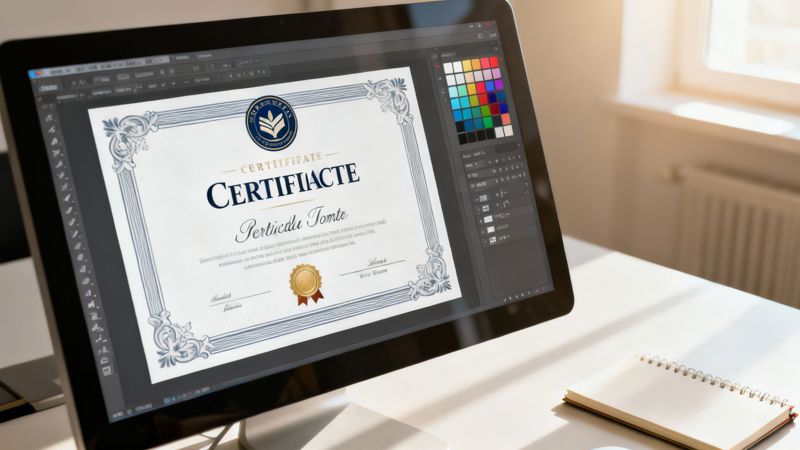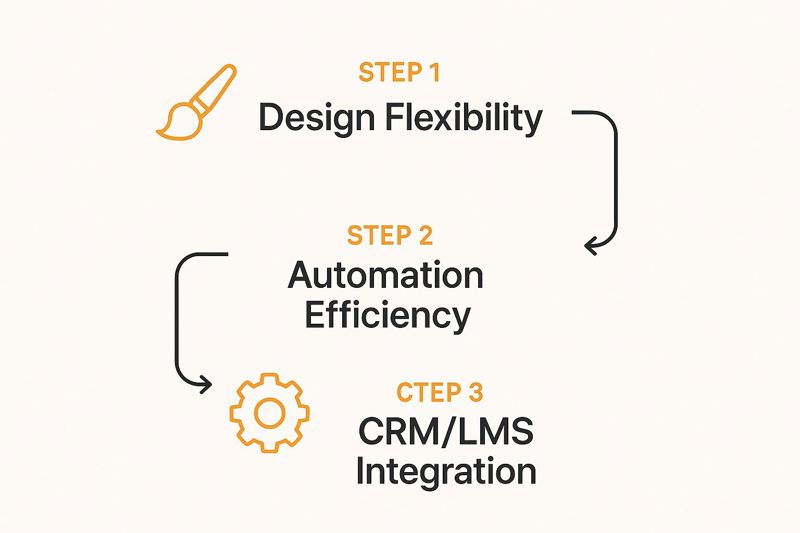Offering a digital certificate isn't just a nice-to-have at the end of a course; it's a savvy move that can turn a learner’s personal win into a serious growth driver for your business. When you make a certificate online, you're doing more than just validating a new skill. You're creating a branded, shareable asset that boosts course completion rates, builds credibility, and transforms happy students into your most vocal advocates.
Why Online Certificates Are a Powerful Growth Tool
In the ever-growing world of online learning, a digital certificate provides a powerful sense of closure and real accomplishment. It’s a tangible reward that validates the time and effort someone has poured into your course, which makes them far more likely to see it through to the end. That psychological win is just the first domino to fall.
When learners feel genuinely proud of their new credential, what do they do? They share it. This simple act turns a certificate into a powerful, organic marketing tool. Every time a graduate posts their achievement on LinkedIn or another social network, they’re giving you authentic social proof and putting your program in front of new audiences you might never have reached otherwise.
Boosting Credibility and Brand Recognition
A professionally designed certificate is like a digital ambassador for your brand. It immediately reinforces the quality and legitimacy of your courses. Think of it this way: every certificate shared online is a personal endorsement, showcasing your brand to a whole network of like-minded professionals and potential new students. You can't buy that kind of authentic marketing.
The global online education market is massive, with an estimated 220 million learners taking at least one online course. A huge part of this is driven by professional development. In fact, 83% of companies use e-learning for training, reporting a 42% increase in productivity as a result. Offering verifiable certificates positions your courses as a serious player in this professional upskilling ecosystem. If you want to dig deeper, you can explore more online learning statistics to see the scale of the opportunity.
Turning Learners into Brand Advocates
The real magic of an online certificate is its ability to convert a one-time learner into a long-term advocate. By giving them a valuable, shareable credential, you're giving them a reason to stay connected to your brand long after they've finished the final lesson.
A well-executed certificate program does more than just acknowledge completion; it builds a community of certified professionals who carry your brand's reputation forward, creating a self-sustaining cycle of credibility and growth.
Of course, this all hinges on making the process seamless and professional. That's where platforms like OKZest come in. They're built to help you generate these personalized, branded assets automatically, so you can focus on creating great content.
Here’s a peek at the OKZest platform, which is designed to automate the creation of personalized certificates and other visuals.

As you can see, the interface lets you design templates that pull in dynamic data. This ensures every single certificate is unique to the recipient while keeping your branding perfectly consistent.
Certificates provide tangible benefits for both your business and your learners. Here's a quick breakdown of the value they add.
Key Benefits of Offering Online Certificates
| Benefit | Impact on Your Business | Value for the Learner |
|---|---|---|
| Increased Course Completion | Higher completion rates improve course metrics and student satisfaction. | Provides a clear goal and motivation to finish the course. |
| Organic Marketing | Graduates sharing certificates on social media acts as free, authentic advertising. | A shareable asset to showcase skills on professional networks like LinkedIn. |
| Enhanced Brand Credibility | Professional certificates signal quality and legitimacy to prospective students. | A verifiable credential that validates their expertise and investment. |
| Community Building | Creates a network of certified professionals who advocate for your brand. | A sense of belonging to an exclusive group of certified peers. |
| Competitive Advantage | Sets your courses apart from competitors who don't offer certification. | A tangible takeaway that adds professional value to their resume. |
Ultimately, integrating a certification program is a win-win, creating a self-reinforcing loop of learner success and business growth.
Designing a Certificate That Embodies Your Brand
When you create a certificate online, you’re doing more than just acknowledging a milestone. You’re crafting a lasting ambassador for your brand—a digital keepsake that constantly reminds people of the value you deliver. The first step to making something memorable is to ditch the generic templates and build something that’s truly yours.
Your brand's visual identity—its colors, fonts, and logo—is its signature. Think of these elements as the foundation for your certificate design. Consistency is everything here. When a certificate feels like it belongs to your brand, it builds recognition and trust. In fact, consistent brand presentation can boost revenue by up to 33%.
Aligning Your Visuals with Your Brand Identity
Let’s start with your color palette. Use your main brand colors for the big stuff, like borders or headers, and sprinkle in secondary colors for smaller accents. This creates that cohesive look that instantly connects the certificate back to your website, course materials, and social media.
Next up is typography. The fonts you pick should match your brand’s personality. Are you modern and clean? Traditional and elegant? Bold and innovative? Whatever it is, own it. Just make sure you use a clear, readable font for the most important details like the recipient's name and the course title. You want those to pop.
To really nail how these elements play together, it’s worth diving into the core principles of visual branding. And if you haven't formalized your visual rules yet, checking out resources on creating effective brand guidelines is a fantastic way to get everything structured.
Structuring Information for Clarity and Impact
A great certificate presents all the key info without feeling cluttered. The goal is to create a visual hierarchy that naturally guides the viewer's eye to the most important elements first.
Here are the must-have components:
- Your Company Logo: Stick it somewhere prominent, usually top-center or in a corner. It immediately establishes ownership.
- A Clear Title: Use a bold heading like "Certificate of Completion" or "Certificate of Achievement." No need to be clever here.
- Recipient's Full Name: This is the star of the show. Make it the largest text on the page.
- Course or Program Title: State clearly what the achievement is for.
- Completion Date: This adds that official touch of validation.
- Issuing Authority: Include your company name or the signature of a key person, like the CEO or lead instructor.
This screenshot from the OKZest dashboard gives you a peek at how you can set up a template with dynamic fields for easy personalization.

Using a tool with dynamic fields makes it incredibly simple to personalize each certificate at scale. This way, every single recipient gets a unique document that still fits perfectly within your brand standards.
The best certificate designs strike a balance between professional validation and brand storytelling. Every element, from where you place the logo to the font you choose, should work together to reinforce the value of the achievement and the quality of your organization.
Choosing the Right Online Certificate Maker
Picking the right platform to create your certificates online can be the difference between a clunky, time-sucking chore and a smooth, professional system. It’s not just about saving time—the right tool elevates the value of your credential and makes your entire program look more polished. You want a solution that grows with you, whether you’re a solo entrepreneur or a larger organization.
This decision has a real impact on your operational efficiency. The professional online course market is on a massive growth trajectory, projected to hit $2.87 billion with a staggering 20.1% CAGR. That growth is fueled by a global push for upskilling, meaning your certification system needs to be scalable from day one.
Core Features to Look For
When you start comparing tools, it's easy to get overwhelmed by a long list of shiny features. My advice? Zero in on the capabilities that will actually make a difference to your brand and cut down your admin work.
If you want a deep dive, we put together a comprehensive guide on finding the perfect online certificate creator that walks you through everything.
But if you’re short on time, here are the absolute non-negotiables:
- Real Design Flexibility: Your certificate is a piece of your brand. You need a tool that lets you fully customize templates with your logo, brand colors, and fonts—not just a platform where you can fill in a few text fields on a generic design.
- Serious Automation: Manually creating certificates one-by-one just doesn't scale. Look for a tool that can automatically generate and email a unique certificate the second a student completes a course or meets the requirements.
- Essential Integrations: Your certificate maker shouldn't be an island. It needs to play nicely with the tools you already rely on, like your Learning Management System (LMS), CRM, or email marketing platform.
The sweet spot is where automation and personalization meet. The less time you spend wrestling with manual data entry, the more time you can pour back into creating amazing content for your learners.
Free Tools vs. Advanced Platforms
The market is full of options, from basic free graphic design tools to specialized, all-in-one platforms like OKZest. While "free" is always tempting, it's important to understand the trade-offs before you commit.
It’s also worth thinking about the different types of Course Management Systems out there and how they might connect with whatever certificate tool you choose.
To help you see the difference clearly, I’ve put together a quick comparison.
Comparing Online Certificate Maker Features
When evaluating certificate creation tools, you'll find a wide gap between what free tools offer and what dedicated platforms can do. This table breaks down the key differences to help you decide which path makes the most sense for your program's needs and future growth.
| Feature | Basic Free Tools | Advanced Platforms (e.g., OKZest) |
|---|---|---|
| Personalization | Limited to manual text entry for each certificate. | Uses dynamic fields and merge tags for bulk personalization. |
| Automation | None. Requires manual creation and distribution. | Fully automated generation and email delivery via integrations. |
| Scalability | Not scalable. Becomes unmanageable with more than a few recipients. | Designed to handle thousands of certificates without manual effort. |
| Brand Consistency | Difficult to maintain a consistent brand across all certificates. | Enforces brand standards through locked templates. |
| Verifiability | Lacks features like unique IDs or validation links. | Often includes unique identifiers for easy verification. |
In the end, the best choice really comes down to your volume and your goals. If you just need to create a handful of certificates a year, a free tool might get the job done. But for any program that plans to grow, investing in an advanced platform is the only way to maintain your professionalism and sanity.
Automating Your Certificate Delivery Workflow
Designing a great-looking certificate is a good start, but the real game-changer is when you can step back and let the delivery process run itself. Manually creating and emailing every single credential is a huge time-drain, not to mention it's incredibly easy to make a typo or get bogged down with delays. An automated workflow is your ticket to scaling up your program and giving learners that instant recognition they deserve.
The idea is to build a completely hands-off system. A specific trigger—like a student finishing a course—should automatically create a personalized certificate and pop it straight into their inbox. This does more than just save you a ton of administrative work; it gives your students immediate gratification, which really reinforces the value of what they just accomplished. It’s all about working smarter.
This infographic breaks down the essential parts of a solid automated system, from the initial design all the way to seamless integration.

As you can see, the right platform acts as the central hub. It connects your design templates with powerful automation tools and the educational software you’re already using.
Connecting Your Tools for Seamless Delivery
To make this happen, you need to link your course platform or CRM with your certificate maker. This is where integration tools like Zapier or Make.com become your best friends. These services are basically bridges that let different apps communicate with each other, no coding required on your part.
Let's walk through a real-world scenario. Imagine a student, Sarah, just completed the final lesson of your "Digital Marketing Mastery" course on Thinkific. Here’s what the automated workflow using Zapier and OKZest would look like:
- The Trigger: Thinkific tells Zapier that Sarah has finished the course.
- The Action: Zapier grabs Sarah's name and email and feeds that information into your OKZest certificate template.
- Generation: OKZest instantly fills out your branded template with Sarah's details and a unique completion date, creating her personalized PDF certificate.
- Delivery: The system then automatically emails the certificate straight to Sarah's inbox.
Within minutes of passing her final quiz, Sarah has a professional credential in hand, ready to share on LinkedIn. That kind of seamless experience feels polished and really boosts her sense of achievement. For a deeper dive into setting these systems up, check out guides on how to automatically send email notifications.
Automation transforms your certification program from a manual, reactive task into a proactive, scalable system. It ensures every single learner receives their credential accurately and instantly, enhancing their experience at the most critical moment of achievement.
The digital certificate market is moving fast, bringing in tech like blockchain and cloud services to make everything more secure and efficient. This shift supports the kind of automated, scalable verification that modern businesses and educational programs need. You can find more insights on the growth of the digital certificates market and what's driving it.
Setting up this workflow is a one-time effort that will pay you back over and over. You’ll be free to focus on what really matters—creating more great content—instead of getting stuck in administrative quicksand.
Turning Every Certificate Into a Marketing Asset
When you hand over a certificate, you’re not just ending a course—you’re kicking off your next marketing cycle. Think about it: when you make a certificate online, you're creating a branded, shareable asset. The real magic happens when you turn that personal achievement into a powerful piece of organic marketing that brings new, qualified leads right to your door.

This all starts by making it ridiculously easy for people to share their new credentials. Professional networks like LinkedIn are goldmines for this. Every time someone shares their certificate, it acts as a powerful, personal endorsement that can drive a ton of traffic from exactly the right kind of audience.
Encouraging Social Sharing on Professional Networks
The secret to getting more shares is to eliminate every bit of friction. Don't just email a PDF and cross your fingers. Instead, you need to build a seamless sharing experience right into the moment they receive their certificate.
When a learner clicks "share," everything should be good to go. You can set this up easily by creating pre-populated social media messages that include:
- A simple congratulatory message: Something like, "I'm excited to share that I've just completed the [Course Name]!" works perfectly.
- A direct tag to your company page: This is crucial. It ensures you get notified and can jump in to engage with their post.
- Relevant hashtags: Include your own branded hashtag (e.g.,
#OKZestCertified) and a few popular industry ones to cast a wider net.
This simple tweak transforms what could be a multi-step chore into a single click, which dramatically boosts the odds that your learners will show off what they’ve accomplished.
Your certificate is more than just a document; it's a social object designed to travel. By making it effortless to share, you empower your audience to become your most effective marketers, extending your brand's reach into valuable new professional circles.
Polishing the Public Landing Page
Every single shared certificate needs to link back to a dedicated, public-facing verification page. This isn't just a technical detail; it's a prime marketing opportunity. That landing page has to look just as professional and on-brand as the certificate itself.
Make sure this page includes:
- Clear Verification Details: The page must prominently show the recipient's name, the course title, and the completion date to confirm its legitimacy.
- Your Branding: Your logo and brand colors need to be front and center, constantly reinforcing who you are.
- A Call-to-Action (CTA): This is where you convert curious onlookers. Add a clear, compelling link like "Learn More About This Program" or "Enroll in Our Courses" to guide interested prospects straight into your sales funnel.
By optimizing this landing page, every certificate that gets shared becomes a lead-generation tool. It offers the social proof a potential student is looking for and gives them a direct path to learn more, turning passive observers into active leads.
Common Questions About Creating Certificates Online
When you decide to make a certificate online, a handful of questions almost always pop up. Getting these right is key to creating something that feels less like a generic image and more like a legitimate credential that people are proud to share.
So, what absolutely has to be on the certificate? Think of it like a formal document. For it to be taken seriously, every professional certificate needs these core elements.
- Recipient’s Full Name: This is the most critical piece of personalization.
- A Clear Title: Something like "Certificate of Completion" or "Certificate of Achievement."
- Course or Program Name: Be specific about what they accomplished.
- Your Company Name and Logo: Show everyone who issued the credential.
- Date of Completion or Issuance: This pins down exactly when it was earned.
- A Unique Identifier: A simple certificate number or ID adds a layer of authenticity that makes a big difference.
Ensuring Security and Verifiability
Another big one is security. How do you make a digital certificate that’s both secure and easy to verify? This is where modern certificate tools really pull their weight. You can't just email a basic PDF and expect it to hold up.
The best way to handle this is by using a platform that generates a unique validation link for every single certificate. When someone shares their credential, anyone can click the link and see a public verification page, confirming all the details are legit. It’s a simple feature, but it’s a powerful defense against fraud and seriously boosts the value of your certification.
Free Tools vs. Paid Platforms
Finally, the big question: can you do all this for free? The short answer is yes, but it comes with some major trade-offs. Free graphic design tools are great for knocking together a nice-looking template, but that's pretty much where their usefulness ends.
The real cost of "free" is your time and your ability to scale. You might save a few bucks upfront, but the manual grind of personalizing, sending, and verifying each certificate becomes a nightmare as your program grows.
Paid platforms, on the other hand, are built specifically for this. They automate the personalization, delivery, and verification, giving you a professional, scalable system that pretty much runs itself. It’s a smart investment in your brand’s credibility and your own sanity.
Ready to create professional, automated, and verifiable certificates that your audience will love to share? OKZest provides the no-code tools and powerful integrations you need to build a seamless certification workflow. Start creating stunning personalized certificates today.